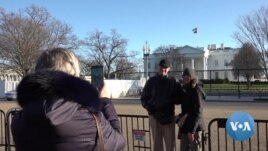14 March 2020
American President Donald Trump is finally getting his wall, but it is not along the southern border with Mexico. It is around the White House.
The White House fence is being rebuilt under the direction of the U.S. Secret Service and the National Park Service. The move comes after several security problems over the years, including a 2014 incident in which a Texas man climbed the fence. He was able to enter the White House without being stopped.
These days, a temporary white barrier interferes with tourists' view of the White House, as the building of the new fence continues.

White House Gets Taller, Tougher Fence to Stop Intruders
The first part of the new barrier is already up. At almost four meters tall, it is nearly two times the size of the former fence. It is also equipped with anti-climb technology.
"Everything, all the pieces, had to be beefed up," says Thomas Luebke. He is secretary of the U.S. Commission of Fine Arts, which advised the Secret Service and the Park Service on the design of the new fence.
The new fence is much different from the very first White House fence. It was made of wood and put up by Thomas Jefferson in the early 1800s. A few years later, he replaced the wooden fence with a stone wall. By 1819, parts of the fence were made of iron.
The early fences were designed to keep out animals, not people. Visitors often freely walked around the White House.
"It was relatively easy to get inside and go upstairs to the second floor. That's where the president worked before the West Wing was built," says Matthew Costello. He is with the White House Historical Association.
President Abraham Lincoln had a doorway cut between his office and his private living area so that he could avoid the crowds waiting outside his office door.
Until the 1920s, presidents decided how open to keep the land around the White House.
In the 1880s, President Grover Cleveland kept the White House completely open, until strangers tried to pick up his children.
President Theodore Roosevelt decided to reopen the White House grounds in the early 1900s, but changed his mind when people kept walking over to the West Wing to see him.
All the presidents up until John Tyler in the 1840s used their own employees to guard the White House.
The U.S. Secret Service took control of security after three sitting presidents were killed between 1865 and 1901.
"Between Abraham Lincoln's assassination, James Garfield's assassination, William McKinley's assassination, if you had been born in 1840, over the course of your lifetime, you would have witnessed three presidential assassinations," says Costello.
During the presidency of Calvin Coolidge in the 1920s, the White House grounds were closed for good to wandering visitors. Since then, anyone who wants to visit the White House must have an appointment.
For the new fence, the U.S. Commission of Fine Arts worked to help balance security improvements to the new fence while keeping the barrier pleasant to look at.
"You actually have to start rethinking the pieces, what they're made of, how well they work together," says Luebke.
The new fence is expected to be completed by 2021.
I'm Susan Shand.
VOA's Dora Mekouar reported this story. Susan Shand adapted it for VOA Learning English. Ashley Thompson was the editor.
Write to us in the Comments Section or on 51VOA.COM.
________________________________________________________________
Words in This Story
tourist – n. one who visits a place for pleasure
beef up – phrasal verb. to increase
relatively – adv. in some way
assassination – n. to kill (someone, such as a famous or important person) usually for political reasons